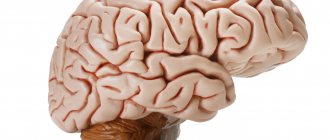User rating
average rating
0
Based on 0 reviews

to relax muscle fibers .
To do this, muscle relaxants are used, which are able to block nerve impulses, which leads to relaxation of the striated muscles. Muscle relaxants are used quite successfully to relieve muscle spasms and cramps, in surgery and certain types of diagnostics, for joint dislocations and complex treatment of osteochondrosis.
What is this?

Their use began with the use of a curare-like agent, tubocurarine chloride, which was isolated by King in 1935 from curare. After an appendectomy performed with the help of a muscle relaxant in 1942, the drugs began to be used more and more often in surgery and other branches of medicine. The general mechanism of action of muscle relaxants occurs due to the blockade of H-cholinergic receptors located in synapses; for this reason, nerve impulses do not reach the striated muscles, and reversible paralysis of skeletal muscles occurs. Relaxation occurs from the facial muscles to the toes and diaphragm.
Ask your question to a neurologist for free Irina Martynova. Graduated from Voronezh State Medical University named after. N.N. Burdenko. Clinical resident and neurologist BUZ VO \"Moscow Polyclinic\".Ask a question>>
The most common drugs in this group: Baklosan, Mydocalm, Sirdalud (tizanidine).
Motor activity is restored in the reverse order.
What to do to relax tense muscles
How to get rid of muscle hypertonicity from panic attacks and VSD? It is quite possible to do this yourself, or you can seek professional help. Let's consider both options. I would like to say right away that you will have to practice relaxing your body for a long time and regularly. When the main tone is removed, it is recommended to maintain the muscles constantly by introducing some procedures and exercises into your lifestyle.
Any method below should be prescribed by a specialist after consultation.
So, what therapeutic methods help relieve muscle spasms:
- Massage. Only a professional massage therapist can properly influence the muscles of the body, relieving tension and spasms. Otherwise, the problem may get worse.
- Osteopathy. This is an area of alternative medicine that involves diagnosing and treating disorders of the anatomical and physiological interaction of individual organs and parts of the patient’s body. The procedure is aimed at restoring functions in the body by eliminating the causes of pain and internal imbalance.
- Acupuncture. An ancient technique of Chinese traditional medicine, using special needles through specific points on the body by inserting them into these points and manipulating them.
- Sharko's shower. Impact hydrotherapy, which is a massage of certain areas of the body using alternating powerful jets of hot and cold water. Not only relaxes muscles, but also strengthens blood vessels.
- Electrophoresis. A physiotherapeutic electrotherapy procedure used to relieve spasms from certain muscles. In combination with medications, it helps relieve not only hypertension, but also inflammation and pain.
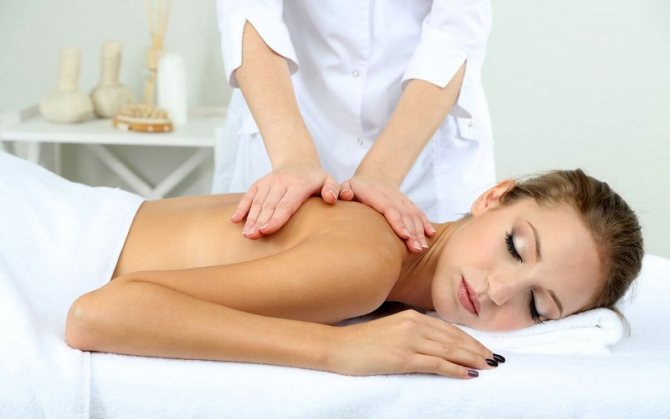
Many VSD workers who go to doctors are prescribed sedative medications. Such pills really help to calm down, reduce anxiety, stop panic attacks, and help with insomnia. While taking them, a person feels more relaxed.
Mechanism of action for osteochondrosis

This strengthens the fixation of the problematic part of the spine, immobilizing it, and also reducing the likelihood of damage and pain when moving. Such a reaction, present for a long time, becomes pathological and contributes to the maintenance of pain. The first stage of osteochondrosis is characterized by the manifestation of a protective reaction of the body in the form of spasm of the spinal muscles, reflex or muscle-tonic syndrome. For this reason, after a certain time, the intensity of the pain increases, and the brain increases the spasm, causing a “vicious circle”. Muscle relaxants for osteochondrosis are used together with other drugs in complex therapy.
Drugs for osteochondrosis can not only reduce reflex syndrome, but also reduce pain.
In this case, increased muscle tone is relieved by centrally acting drugs that provide the following effects:
- Muscle spasms are partially or completely eliminated.
- Make it possible to reduce the dose of other medications and the duration of treatment, reducing the likelihood of side effects from anti-inflammatory drugs.
- Makes physical therapy, exercise therapy, massage and manual therapy more effective.
For osteochondrosis, it is permissible to take muscle relaxants only as prescribed by a doctor. The drug must be taken in a medical facility for the first time.
Thus, in the event of the possible occurrence of severe side effects, the patient can be promptly provided with qualified assistance.
Relaxation to calm your nerves - 3 effective techniques
There is a version that auto-training arose quite a long time ago. Back in the 20th century, a neuropsychologist named Oskar Vogt discovered that some of his patients had the ability to independently enter a trance or hypnotic state when they needed it.
From that moment on, relaxation for the nervous system began to rapidly gain momentum. There were many other scientists and psychiatrists who determined the pattern of earlier recovery using similar techniques.
There is also a version that yogis have had the ability to self-soothe themselves since ancient times. This is available to them without the help of auto-training; they cope with such situations using other methods.
But still, the most important person in the history of the development of auto-training is considered to be Johann Heinrich Schultz. He worked as a neurologist in the city of Frankfurt am Main and already in 1936 became the head of the Institute of Psychotherapy. His main work was the therapy of the mentally ill. In those years, he made many discoveries on the topic of relaxation of the nervous system and the system of calming the human psyche.
Schultz published his own work entitled “Autogenic Training,” which was subsequently translated into many foreign languages.
Three execution techniques
Meditation does not require special equipment or effort of concentration. As a rule, it is performed while sitting with your eyes closed.
Breathing exercises
A brain that receives a sufficient amount of oxygen works more efficiently, which means that the decisions a practitioner makes become more balanced.
- Prepare a practice area.
- Find a comfortable position and close your eyes.
- Watch every inhalation and exhalation, trying to keep them smooth and deep.
- Relax all the muscles in your body.
- When all unpleasant emotions go away, slowly take a deep breath and open your eyes.
After completing your meditation, do not make sudden movements. Allow yourself to integrate into current affairs in a measured way. Meditation practice is good for beginners, as it is easy to perform and allows you to regain a sense of peace and harmony. The functions of the respiratory system return to normal, which has a positive effect on brain function.
records
A good solution for those who have just come to the practice would be audio meditation. All you need is any device that can play the recording.
You can practice in transport, walking in the park, at work or school, lying in the bathroom. In a public place you can listen to recordings using headphones.
If they are accompanied by instructions from the speaker for any actions, it is better to do it at home so as not to disrupt the structure of the practice.
Calming Meditation:
Calm your nerves in 8 minutes:
Visualization
Visualization is a very powerful tool that has a beneficial effect on the practitioner. The essence of this method is to imagine an object that generates pleasant experiences in the brain and transfers them to real life. Such meditation allows you to heal the nervous system, restores harmony, eliminates illnesses, and restores harmony of body and mind.
Legendary meditation course for free We recommend! The most popular meditation course for beginners in Russian. More than 100 thousand people have already learned to meditate. Try it yourself. Read more.
Technique:
- Prepare your practice room.
- Position your body in a comfortable position.
- Relax your body and focus on your breathing.
- Clearly visualize what you sincerely strive for.
- Allow the emotions of joy, happiness, and calm to take over you.
- To complete the practice, take a deep breath and open your eyes.
When practicing visualization meditation, try to see not an abstract image, but a real picture that you sincerely strive for. In order to achieve harmony, imagine a place where you feel good and calm: the sea coast, mountain peaks, forest clearing. Your place should be secluded, away from the hustle and bustle and people.
Relaxation before bed
Let's consider a simple technique that allows you to enter the halls of the parasympathetic nervous system:
- Lying on your back, build a comfortable body position, take full breaths and exhales through your nose.
- As you inhale, allow your belly to rise so that your navel rises up; as you exhale, it should fall naturally.
- Feel the reliable support under your body. The floor or bed supports you, lean your whole body on it.
- Inspect all parts of the body with your inner gaze, relaxing them. Your body becomes soft and pliable and heavy.
- Continue to immerse yourself in a state of calm and tranquility deeper and deeper.
- Release tension from the muscles of your face and neck.
- If your inner gaze detects tension in any part of the body, as you exhale, feel how it comes out along with the air.
- Allow yourself to remain in this healing state that restores soul, body, mind
- When you feel that the time has come, smoothly exit the practice.
- Take a closer look at what transformations happened to you after practice. Meditate daily, this will help you learn to quickly enter a state of relaxation.
Meditation practice is the best way to relieve stress and tension accumulated during the day. By devoting time to meditation every day, you will see how much the quality of your life has changed. She was painted with harmony and joy, happiness and peace.
Who is auto-training intended for?
Autotraining has a number of useful properties for every person. There are special complexes aimed specifically at women or men. They have significant differences. But there are also combined sets of exercises that do not differ in their effects on a person by gender.
Source: https://cosmeton.ru/zdorove/autotrening-dlya-uspokoeniya-nervnoj-sistemy.html
Groups of muscle relaxants
The classification of muscle relaxants involves dividing them into groups according to certain characteristics. Thus, centrally acting muscle relaxant drugs have differences in their chemical structure, and peripherally acting drugs differ in their ability to change electrical activity in the synapse.
Peripheral muscle relaxants
They block nerve impulses traveling to the muscles along the fibers. They are used for anesthesia, paralysis during tetanus or for convulsions . In turn, they are divided into:
- Depolarizing drugs. Upon contact with receptors, persistent depolarization of synaptic membranes occurs during short-term myofasciculation, which turns into muscle relaxation. The muscle receives this relaxation for a short time. This type of drug includes Lystenon , which, due to possible complications, is gradually being replaced with short-acting muscle relaxants.
- Muscle relaxants are non-depolarizing. Capable of blocking membrane channels and receptors without depolarization. The duration of the effect depends on the specific drug. This group includes Tubocurarine, Pancuronium, Mivacurium, Atracurium, Doxacurium .
Central muscle relaxants

Classification by duration
Depending on the duration of the neuromuscular block that causes the use of a particular muscle relaxant, the classification of drugs will include the following groups:
- Ultra-short-acting depolarizing muscle relaxants (less than 5-7 minutes). For example, Suxamethonium, Ditilin, Listenone .
- Non-depolarizing muscle relaxants:
- Short-acting (less than 20 minutes): Mivacurium ;
- Medium action (up to 40 minutes): Vecuronium, Atracurium ;
- Long-acting (more than 40 minutes): Pancuronium, Tubocurarine .
Antispasmodics
This type of drugs includes drugs that can relieve spasms of smooth muscles of internal organs and blood vessels.
Popular drugs: drotaverine, nitroglycerin, no-spa.
They are used in the treatment of pathologies such as renal colic, bronchial asthma, etc.
Auto-training to calm the nervous system
The life of any modern person is filled with many different events. And it’s good if these events give joy and positive emotions.
But sometimes this or that situation in which a person finds himself not only does not bring him any pleasure, but also negatively affects his nervous system.
A person begins to get angry and behave aggressively, becomes nervous and irritable, and may develop psychological disorders.
Although there are many different ways to improve mental health, one of the most effective methods is auto-training to calm the nervous system. Today we’ll talk about what auto-training is, what its essence is, what auto-training exercises can be called the most popular and effective.
Auto-training to calm the nervous system: what is it?
Autotraining is a special psychological technique based on self-hypnosis that helps calm the nervous system, restore peace of mind and inner balance, and restore the balance of biochemical processes occurring in the human body.
Every person who believes in himself and his strengths is endowed with the ability to inspire himself with anything.
Although many psychologists classify auto-training as a type of hypnotic influence on the subconscious, unlike hypnosis, the person practicing auto-training is directly involved in this process. Doctor I.
Schultz, who can rightfully be called one of the creators of autogenic training, argued that autotraining to calm the nervous system is a person’s conscious regulation of his own psycho-emotional state.
Auto-training for relieving nervous tension is valuable because you can independently control the tone of your muscles, concentrate on the results you want, and evoke the emotional state you need at will.
Auto-training is indicated for people who experience neuroses, neurasthenia, panic attacks, apathy, irritability, and depression.
In combination with basic treatment, auto-training helps to cure illnesses based on emotional stress, such as endocarditis, hypertension, constipation, bronchial asthma, and some disorders of the gastrointestinal tract (GIT).
Children and pregnant women can practice auto-training to calm the nervous system.
If a person experiences vegetative crises, somatic attacks, states of unclear consciousness and delirium, then it is better for him not to engage in auto-training, but to find another way to improve his psychological health.
30 – 50 minutes of auto-training is equivalent to 3 – 5 hours of a full night’s sleep. Auto-training has a powerful healing effect: it not only perfectly calms the nervous system, but also improves hormonal levels, normalizes emotional state, pulse and blood pressure, and reduces feelings of restlessness and anxiety.
A few important rules
If you want to achieve the necessary results using auto-training exercises to calm the nervous system, you should follow the following rules.
✔ During the process of auto-training, nothing should disturb you, so find a quiet and peaceful place in the house in advance, warn your household that you need to spend some time alone with yourself and your thoughts. Don't forget to turn off your phone!
✔ Choose a position that is convenient and comfortable for you in advance. You can lie down or sit. Legs and arms cannot be crossed.
✔ Your clothes should be loose and not restrict your movements.
✔ If you listen to an audio recording, you will need to repeat all the phrases said by the audio instructor out loud.
✔ If you don’t want to listen to an audio recording, but prefer your own installation text, then you can write all the phrases you need yourself. It should be remembered that the text should not contain the particle “not”.
Write simple and short positive statements in the first person and in the present tense. “I won’t get angry and upset over trifles”, “I don’t want to behave aggressively” are incorrect attitudes.
“I feel relaxed,” “I feel like my nervous system is relaxing,” “I am in harmony with myself and the world around me” are the correct attitudes.
✔ Be fully aware of the words you speak. Under no circumstances do this automatically!
✔ Repeat all the installation phrases several times so that they are better consolidated in your subconscious.
Auto-training exercise No. 1. Breath control
By learning to control your breathing, you can effectively influence tense areas of your body and emotional parts of the brain. Thanks to this, your nervous system will calm down, and you will feel inner harmony.
Experts say that there are two types of breathing: using the abdominal muscles and chest breathing. The first breathing option helps to relax tense areas of the body. Breast breathing provides tension, which the body sometimes really needs to improve mental health and ensure a high level of activity.
How to breathe correctly using your abdominal muscles to calm your nervous system? Counting to yourself from one to four, slowly take a deep breath.
Your chest should be motionless, with only your stomach protruding forward. Hold your breath for a few seconds and then exhale smoothly, counting from one to six.
It is necessary to hold your breath for 5–8 seconds before the next inhalation.
While performing the auto-training exercise, say the following phrases: “I am calm,” “My arms and legs are warm and heavy,” “My heart beats rhythmically and calmly,” “I breathe evenly and deeply.”
⚑ Duration of exercise – 2 – 4 minutes. This exercise must be performed for 14 to 18 days.
Auto-training exercise No. 2. Verbal influence on the subconscious
The mechanism of self-hypnosis effectively affects the psychophysical functions of the human body. Correctly formulated guidelines (see section “A few important rules”) will help calm the nervous system, get rid of irritation and apathy, improve mental health, and gain peace of mind and harmony.
Find a calm and quiet place, take a comfortable position, close your eyes and concentrate all your attention on your inner sensations and experiences. If you use an audio recording with installation phrases, then do not forget to turn it on.
You should feel all parts of your body and try to relax them: first your right leg, left leg, stomach, chest, then your right arm, left arm and head. Feel how a pleasant warmth spreads through your body, your muscles completely relax, and your body becomes heavier.
If you use your own set phrases, then start saying them out loud or to yourself. External noise and extraneous sounds should not exist for you. You hear only the voice of the audio instructor or your own voice, which speaks positive, clearly worded, short and easy to understand phrases.
Repeat the setting phrases several times, and then focus on your breathing. Your breathing should be calm, slow and even. With each subsequent exhalation, your body relaxes more and more, and you yourself feel only peace and harmony. You should not experience any bright or strong emotions while performing this exercise.
Watch your thoughts, but don't overthink them, but let them come into your head freely and leave freely. Start visualizing and try to mentally “see” how you are walking along the seashore, field or forest edge, flying with the birds in the sky, etc. All the pictures you imagine should be pleasant and bright. No negativity!
Begin to gradually emerge from a relaxed state. First move your left leg, then your right leg, then your left arm, and then your right arm. Open your eyes only when you begin to feel your body again.
Auto-training exercise No. 3. Muscle tone control
A person who often experiences negative emotions and has problems with the nervous system may experience muscle tension. To get rid of muscle tension and quickly restore strength, you need to learn how to properly relax your muscles.
If auto-training is carried out correctly, then after performing this exercise a feeling of warmth and pleasant heaviness should appear in the muscles. Experts advise beginners to first pay attention to certain areas of the body, since it is not always possible to immediately relieve nervous tension in all muscles.
To perform this auto-training exercise, you should lie down on a flat and soft surface. Start breathing deeply, taking slow and smooth inhalations and exhalations. Mentally try to find the most tense areas of your body.
Focus all your attention on these areas and as you inhale, try to tighten the clamps even more. You should feel the muscle tension that appears as a result of your actions, and then sharply release it as you exhale.
Repeat this procedure several times until you feel that the tension in the muscles has completely disappeared.
⚑ Duration of exercise – 2 – 3 minutes. The exercise must be repeated for 4 to 7 days.
Meditation before bed. 5 effective techniques
Auto-training exercise No. 4. Heart rate alignment
The purpose of this exercise is to calm the cardiac system and equalize the heart rhythm. You should lie down on a soft and flat surface and place your right hand on the heart area.
Try to relax your entire body. Breathe evenly, slowly and deeply. Start saying the following attitude phrases out loud or silently: “I am calm,” “My body is in a relaxed state,” “I feel warmth and heaviness throughout my whole body,” “My heart beats rhythmically and calmly.”
⚑ Exercise duration – 90 – 110 seconds. It should be repeated for 10 – 14 days.
Auto-training exercise No. 5. Warming the solar plexus
It has long been scientifically proven that warming the abdominal cavity in the solar plexus area calms the central nervous system, making a person more calm and balanced.
You need to lie down on a soft and flat surface, close your eyes and relax your body. Breathe slowly and deeply. Start repeating the following installation phrases: “I am calm and relaxed,” “I breathe evenly and deeply,” “My heart beats rhythmically and calmly,” “I feel a pleasant warmth in the solar plexus.”
⚑ Duration of exercise – 3 – 5 minutes. This exercise must be performed for 20 – 22 days.
Source: https://BestLavka.ru/autotrening-dlja-uspokoenija-nervnoj-sistemy/
Indications for use
Muscle relaxants are most often used in the following cases :
- To ensure acceptable conditions for tracheal intubation.
- When performing mechanical ventilation to suppress spontaneous breathing.
- When eliminating convulsive syndrome, when anticonvulsants are ineffective.
- During surgical interventions, to ensure optimal working conditions for surgeons without the use of excessive doses of anesthetics, muscle relaxation and certain diagnostic procedures that are performed under general anesthesia (for example, bronchoscopy).
- When reducing dislocations and repositioning bone fragments in places of powerful muscle masses.
- Blockade of muscle hypertonicity during artificial hyporhythmia and the body's protective reaction to cold - muscle tremors.
Pharmacological agents for muscle dysfunction
After a person has undergone a series of examinations and passed all the tests prescribed by the doctor, he can make sure that there are no somatic diseases. Such pathologies include stroke, obliterating type of arthritis, venous obstruction, organic disorders and some other pathologies.
If other problems are not identified, it means that the person has vegetative-vascular dystonia. How to get rid of this pathology? First of all, by changing your usual lifestyle:
- inclusion of walks outside in the daily routine;
- regular exercise;
- giving up bad habits;
- physical therapy exercises;
- undergoing physiotherapeutic procedures;
- normalization of sleep patterns;
- taking a contrast shower every day.
In addition to general recommendations, on the advice of a doctor, you can use the following drugs:
- Minerals and vitamins that have a strengthening effect on the nervous system: preparations must contain calcium, potassium, magnesium, vitamins belonging to group B, selenium (Magne B6, Kombilipen, Revit, Alphabet).
- Immunomodulatory enzymes that increase the body's defenses (Wobenzym).
- Mild sedatives that gently calm the excited nervous system (infusions and teas with the addition of motherwort, lemon balm, mint, peony, Sedavit, Novo-Passit). Vasodilators that improve vascular patency and blood flow (Mexidol, Cavinton).
- Beta-blockers that regulate the activity of the cardiovascular system (Atenolol, Egilok). Anticholinergic drugs that relieve hypertonicity of muscle fibers (Benztropine, Akineton).
- In order to relieve strong nervous tension that prevents simple movements, botulinum toxin injections are used, which have the property of relaxing muscles.
To prevent tense muscles from interfering with everyday life, you should remember that all illnesses come from the head. Only by throwing out all the problems, worries and fears, allowing the body to relax and maintaining a healthy lifestyle, can you forget about the debilitating tension of the muscles of the body for a long time.
Source: vsdpanika.ru
РњРЅРѕРіРёРµ замечают, что стрессы вызывают напряженРёРµ мышц. Если это напряжение РЅРµ SЃРЅРёРјР°С‚СЊ, то RїРѕ RїСЂРёРЅС†РёРїСѓ RѕР±СЂР°С‚ РЅРѕР№ СЃРІСЏР·Рё РѕРЅРѕ само будет выз S‹РІР°С‚СЊ S‚ревогу. Поэтому желательно SЋS‰РеРµ S‚ехнРеРєРё.
Рљ сожаленоЋ, мало Рѕ онформации Рѕ том, что РІ зависимости R ѕС‚ степени напряжения R ±СѓРґСѓС‚ работать SЂР°Р·РЅС‹Рµ S‚ехники, РІ то время RєР°Рє РґСЂСѓРіРёРµ Р±СѓРґСѓС‚ почти бесполеР·РСС‹. Дальше СЏ опишу RєРѕРіРґР° Рё какие S‚ехнРеРєРё SЂР°СЃСЃР»Р°Р±Р»РµРЅРёСЏ Р±СѓРґСѓС‚ R SР°Реболее эфф RµRєS‚ивными.
Занимаясь S‚елесными практиками, СЏ выделил несколькР* механизмов расслабления мышц, Рё разделил РёС… РЅР° РґРІРµ большРеРµ РіСЂСѓРїРїС‹: внешние
Ryo
внутренние
.
К первой группе
относятся: массаж, разогревание, перенапряжение, Рґ ыхательные практРеРєРё.
Рљ РіСЂСѓРїРїРµ «РјР°СЃСЃР°Р¶» СЏ также отно€Сѓ растягивающРеРµ РіРіРјРЅР °СЃС‚РёРєРё, сеансы мануальны S… S‚ерапевтов, РєРенезРеологов, S‚елесныS… S‚ерапевтов Рё прочих спецРеалистов, раб отающих СЃ мышцами.
Рљ разогреванию относятся баня, горячая ванна, РіРѕСЂСЏS ‡РёР№ РґСѓС€, согревающие мази, различные SЃРѕРіСЂРµРІР°СЋС‰РёРµ РїСЂРёР±РѕСЂС‹. Р'оздействРеРµ повышенной температуры также заставляет мышцы SЂР°СЃСЃР»Р°Р±Р»СЏС‚СЊСЃСЏ.
RџRѕRїSѓR»СЏСЂРЅС‹Рј SѓРїСЂР°Р¶РЅРµРЅРёРµРј для SЃС‚радающих паническиРјРё атаками Рё Р'РЎР” является перенапряжение мышц. Мышцы напрягают максимально сильно РІ течение как Рј ожно большего времени, после С‡ его РѕРЅРё автоматически SЂР°СЃСЃР»Р°Р±Р»СЏСЋС‚СЃСЏ. RS‚Рѕ РїСЂРѕРёСЃС…РѕРґРёС‚ РёР·-Р·Р° того, что Сѓ мышц есть RѕРїСЂРµРґРµР»РµР Sный СЌРСергетический запас. После его расходования РѕРЅРё больше РЅРµ RјРѕРіСѓС‚ РЅР°РїСЂСЏРіР°С‚С ЊСЃСЏ. РЈРІС‹, РїСЂРё очень SЃРёР»СЊРЅРѕРј мышечном напряжении этот РјР µС‚РѕРґ практически бесполезен.
Последний механизм РёР· этой РіСЂСѓРїРїС‹ — дыхательные прак S‚РёРєРё. R›СЋРґРё СЃ хронической тревогой дышат РіСЂСѓРґСЊСЋ. Такое дыханое способствует дополнительному мышечному напряжению. Рђ РІ крайних случаях РїСЂРёРІРѕРґРёС‚ Рє RіРіРїРµСЂРІРµРЅС‚иляции. Переход РЅР° диафрагмальное дыхание RїРѕРјРѕРіР°РµС‚ РєР°С‡РµСЃС ‚венно расслабляться.
К внутренним механизмам
SЂР°СЃСЃР»Р°Р±Р»РµРЅРёСЏ мышц относяS‚СЃСЏ S‚ехннки SЃРЅСЏС‚РёСЏ напряжения медитативного S…аракт ера.
МедитацРеРё снимают изначальную S‚ревогСГ, РёР·-Р·Р° которРѕР№ РјРѕР·Рі посылает РјС‹ шцам сгналы напрягаться, С‚.Рµ. работают СЃ причиной напряжения
.
Перечисленные RјРµС‚РѕРґС‹ нужно RїСЂРёРјРµРЅСЏС‚СЊ РІ зависимо сти РѕС‚ СѓСЂРѕРІРЅСЏ напряжения
. RљРѕРіРґР° S‡РµР»РѕРІРµРє S‡СѓРІСЃС‚вует бессилие, RїРѕСЃС‚РѕСЏРЅРЅСѓСЋ S‚СЂ евогу Рё разбитость СЃ самого утра, РЅРµ СЃРїРѕСЃРѕ±РµРЅ расслабиться лежа РЅР° РґРеване, РЅР°Реболее SЌС„фективными Р± SѓРґСѓС‚ растягиваюS ‰РеРµ РіРемнастРеРєРё Рё дыхательные практРеРєРё. Физкие нагрузки RїСЂРё SЌS‚РѕРј вызывают SѓСЃС‚алость, R ЅРѕ РЅРµ РїСЂРёРІРѕРґСЏС‚ Рє расслаблению. Медитативные SЃРѕСЃС‚РѕСЏРЅРёСЏ S‚акже РЅРµ достижимы РњР·-Р·Р° СЃР ёР»СЊРЅРѕР№ тревоги перенапряжения.
RљРѕРіРґР° напряжение станет SѓРјРµСЂРµРЅРЅРј, Р° тревога SЌРїРёР·Р ѕРґРёС‡РµСЃРєРѕР№, RјРѕР¶РЅРѕ RїРѕРґРєР»СЋС‡Р°С‚СЊ R»РµРіРєРёРµ S„РёР·РёС ‡РµСЃРєРёРµ SѓРїСЂР°Р¶РЅРµРЅРёСЏ Рё начинать осваивать RјРµРґРёС‚ации. Физические упражнения должны вызывать небольшую R јС‹С€РµС‡РЅСѓСЋ СѓСЃС‚Р°Р»РѕСЃС ‚СЊ, РЅРѕ, РЅРё РІ коем случае РЅРµ переутомление. RџРѕРєР°Р·Р°С‚елем SЃСЂРµРґРЅРµРіРѕ SѓСЂРѕРІРЅСЏ напряжение SЏРІР»СЏРµС‚СЃСЏ достаточное количество SЃРёР» для выполнения повсеРґРЅРµРІРЅС ‹С… дел Рё средний уровень SѓСЃС‚алости SѓС‚СЂРѕРј.
РљРѕРіРґР° общее напряжение SЃС‚анет незначительным, Рё Р±С ѓРґРµС‚ появляться SЌРїРёР·РѕРґРёС‡РµСЃРєРё RїРѕСЃР»Рµ стресса, можно сосредоточиться РЅР° дыхательных Рё Р јРµРґРёС‚ативных техниках . РќР°Реболее доступна пЃтогенная S‚ренировРДР° РїРѕ ШульцS G. ТехнРеРєР° РѕСЃРІР°Ревается довольно RјРµРґР»РµРЅРЅРѕ, РЅРѕ дает отличный результат. После освоенвоаутогенной S‚ренировки пли РґСЂСѓРіРѕР№ РїРѕ РґРѕР±РЅРѕР№ практРеРєРё, Р·Р° RїРѕР»С‡Р°СЃР° RјРѕР¶РЅРѕ SЂР°СЃСЃР»Р°Р ±РёС‚СЊ S‚ело лучше, чем Р·Р° 8 часов СЃРЅР°.
Подбирайте RїРѕРґС…одящие SЂР°СЃСЃР»Р°Р±Р»СЏСЋС‰РёРµ S‚ехники РІ завис имости РѕС‚ вашего S‚екуS ‰РµРіРѕ состояния, это обязательно даст результат. Рђ расслабленное S‚ело поможет SЃРЅРёР·РёС‚СЊ RѕР±С‰РёР№ уровень S‚ревоги даст вам SЃРёР».
RҐРѕСЂРѕС€РµРіРѕ R'ам настроения!
Source: www.b17.ru
Admission rules
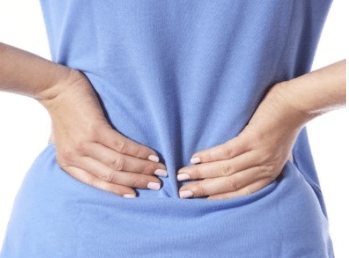
The type of medication, dose and duration of therapy are prescribed individually by the attending physician. The average duration of the course is 3-7 days, but if necessary, it can be extended to weeks or months with mandatory monitoring of the patient’s condition. The method of administration of muscle relaxants is injection or oral, with the latter being more common. It is not advisable to take the tablets on an empty stomach, so as not to damage the mucous membrane, and when consuming them, wash them down with water. In the absence of special recommendations, injections and tablets are taken twice a day. After individual selection of the drug, administration begins with a minimum dose and gradually increases it. When the desired result is achieved, the dose is gradually reduced until completely discontinued.
Abrupt withdrawal of muscle relaxants is prohibited, as it is dangerous for the development of high blood pressure and tachycardia.
What spasms torment VSD sufferers?
Spasms in dystonics can occur in various parts of the body - from the neck to the lower extremities. However, there are several common areas that can be identified.
- Often, spasms in dystonics occur in the abdomen. accompanying symptoms are often bloating, rumbling, nausea, loss of appetite, abnormal stool consistency, increased gas formation, constipation or diarrhea. The reason for this is increased intestinal sensitivity, increased peristalsis activity and disruption of the natural balance of digestive function.
- Another “target” in many cases is the chest area. In this case, a person develops respiratory problems, a feeling of suffocation, tachycardia, a feeling of embossing, severe discomfort and squeezing in the chest.
- VSD sufferers are often also plagued by a feeling of squeezing and spasms in the throat. These manifestations are accompanied by symptoms such as dry mouth, difficulty swallowing, and a lump in the throat.
- With cervical osteochondrosis accompanying VSD, the patient is bothered by spasms in the neck and shoulders, spots in the eyes, noise or ringing in the ears, headaches, and general weakness throughout the day.
Any muscle spasms during VSD are usually accompanied by the following manifestations:
- increased blood pressure;
- dizziness;
- numbness or coldness of the extremities;
- frequent urination;
- heart rhythm disturbance;
- trembling in the body and limbs;
- anxiety for no reason, nervousness, panic attacks.
In order to get rid of any unpleasant physiological symptoms, dystonics need to normalize their psychological state. In addition to psychotherapeutic sessions, there are also methods that help temporarily alleviate the condition.
Contraindications
Along with relieving patients of tension and spasms, which normalizes the patient’s condition, muscle relaxants are not suitable for everyone. The main contraindications for this group of drugs are as follows:
- Hypersensitivity to the active and excipients.
- Kidney failure and liver pathologies.
- Mental disorders (considered individually).
- Convulsive syndrome.
- Parkinson's disease.
- Drug addiction.
- Myasthenia.
The use of muscle relaxants during pregnancy and breastfeeding is determined on an individual basis.
In most cases, this type of drug is not used at these stages, as it can potentially cause harm to the fetus.
Prevention of treatment of VSD and osteochondrosis
VSD and cervical osteochondrosis symptoms may not appear immediately. A simple neck pain is unlikely to arouse suspicion. After a certain stage of time, it will become obvious that the disease has begun to progress. According to experts, it is better to prevent the disease in advance by taking the following points as rules:
VSD and osteochondrosis can be prevented, and there is no need to do anything complicated for this. If you feel weak and dizzy, constant pain in the neck makes it difficult to sleep, run to the doctor, since osteochondrosis of the cervical vertebra is considered the most difficult of all, and it can lead to dire consequences.
Side effects and overdoses
Most of the side effects after taking muscle relaxants are caused by a drop in blood pressure, which contributes to dizziness, asthenia, and impaired coordination of movements, and sometimes the patient can lose consciousness . The following side effects may occur after taking medications:
- Dry mouth, nausea and vomiting.
- Diarrhea or constipation.
- Problems with urination.
- Decreased muscle function and sensitivity.
- Increased drowsiness, poor concentration, confusion. These consequences exclude the possibility of using muscle relaxants for people driving vehicles and engaged in activities that require increased concentration.
- Allergic manifestations: exanthema and breathing disorders.
- Psycho-emotional disorders: euphoria, depression, increased irritability.
- With prolonged use - weight gain.
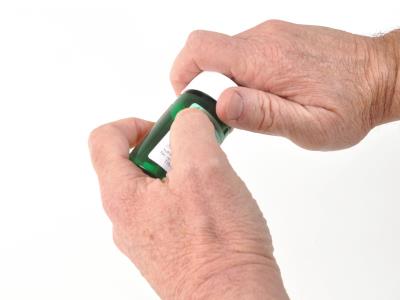
Thus, Suxamethonium drugs provoke bradycardia and the appearance of hyperkalemia, as well as muscle pain during the postoperative period. But the increased gastric pressure caused by depolarizing muscle relaxants does not increase the risk of pulmonary aspiration or gastric reflux. In case of overdose of depolarizing drugs, their physiological antagonists are used - anticholinesterase drugs. Depolarizing muscle relaxants after an overdose do not allow the use of anticholinesterase drugs, since the latter will only enhance their effect.
In this case, they use the introduction of citrated blood with the enzyme pseudocholinesterase, which destroys dithiline.
Cotton legs and alien hands
Vegetative-vascular dystonia, manifested by vegetative muscle tension in the muscles, cannot be controlled by the mind. The nervous system, experiencing a disorder in the functioning of its own departments, puts pressure on the work of the whole organism, one of the reactions of which is muscle tension. Due to the fact that such a state cannot be realized in the form of physical activity, it produces spasms, convulsions, peaks and other reactions from the human body.
The same applies to the hands, they seem to become strangers, not following the commands that the human brain sends to them. Overstrained muscle fibers affect the tissues surrounding them, causing the development of unpleasant pain, not only in the muscles, but also on the surface of the skin.
Muscle strain can worsen if a person performs heavy physical work, engages in active mental activity, or experiences a stressful situation.
Common symptoms of this condition are:
Requirements for muscle relaxants
All modern muscle relaxants are characterized not only by their effectiveness in relieving muscle tension, but also meet the following requirements:
- The relaxation effect should be selective: when relaxing muscle tone, do not suppress tonic pulsation. After using the drugs, the person must retain the ability to move independently.
- Be safe, which is especially important with prolonged use, since a person should not lose the ability to lead a normal life and work.
The drug Mydocalm, which has been used in domestic and foreign medicine for more than 40 years, meets all the above requirements.
It simultaneously prevents the formation of action potentials, reduces increased impulses and helps slow down hyperactive reflexes, while not interacting with ethanol.
How to relieve muscle tension yourself
Not everyone has the time or money to attend professional procedures. There are also home methods that allow you to free your body from muscle spasms and tension.
- Exercises. This is perhaps the most effective independent way to get rid of excessive stress. Not all types of exercise are aimed at relaxation. There is a lot of information on this topic on the Internet and anyone can find a suitable set of exercises to relax the muscular system. For your information, there is nothing better than yoga in this area.
- Autogenic training. A great way for those who are too lazy to exercise. This is a psychotherapeutic technique that allows you to influence the body with your own consciousness.
- Meditations. Another wonderful type of relaxation that will not only remove all the blocks in the body, but also in the head, or more precisely, in the thoughts. The only negative is that results may not appear soon, since the technique requires mastery and strict regularity.
- Baths. Suitable for those who do not have a problem. Warm baths with aromatic oils shortly before bedtime are good for relaxing the body. Favorite music will enhance the effect.
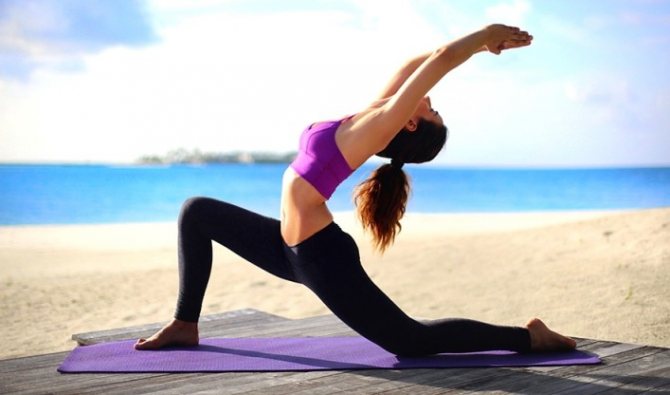
You can add walks, positive emotions, and more physical activity to independent methods of relaxation. And don't forget about thinking. After all, it is precisely this that often becomes the cause of panic and anxiety attacks.
If you find an error, please select a piece of text and press Ctrl+Enter. Thank you for your attentiveness and help!
Many patients suffer from muscle pain due to VSD. Tight muscles put pressure on other tissues and nerve endings. This leads to the person's legs twisting and cramps appearing. Often there is torticollis (the person cannot move the neck) and blephorospasm (the person cannot control blinking). If the patient is constantly under stress, his condition worsens.
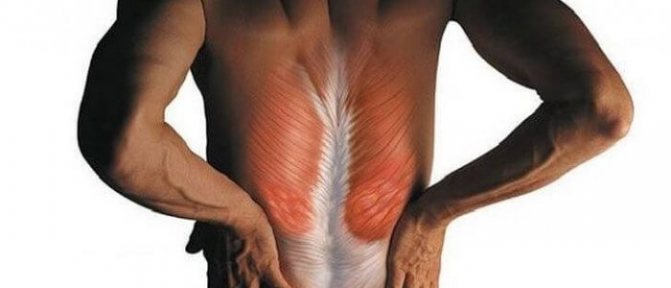
Physiotherapy
Exercises aimed at stretching the spine help maintain correct posture, maintain flexibility, and relax muscles. You cannot perform exercises through pain, so you need to prepare for gymnastics.
To do this, relax, sit on the edge of a hard surface, lean back and pull your legs to your chest with your hands. It is necessary to achieve a position in which the pain goes away. After a couple of minutes, you can carefully stand up so as not to strain your muscles.

To release accumulated tension from your upper back, you need to lean back in your chair with your hands on the back of your head. After a couple of minutes, carefully lower your hands. By changing postures, everyone can find a position in which the muscles relax.
Back exercises should be performed at an average pace, repeating each exercise several times, then rest a little.
1. Lie on your stomach without lifting your pelvis from the floor; you need to do push-ups on your hands, arching your back.
2. Lie on your back. Bend your knees, press your feet to the floor. Cross your arms, place your palms on your shoulders. Raise your head and shoulders high, without lifting your feet and lower back from the floor. You need to stay in this position for a few seconds.
3. Lie on your stomach, raise your right leg and left arm, imitating crawl swimming. Hold in each position for 2 seconds.
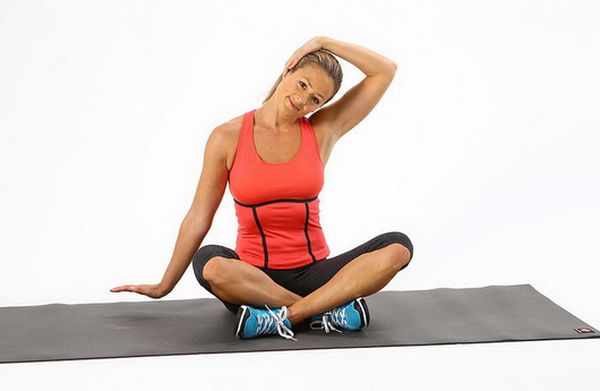
For back pain, swimming is recommended. Only the water in the pool should be warm.
How to relax your neck muscles? You need to perform each exercise five times in the morning and evening. The first two weeks you need to perform the first three exercises, later add the rest.
- Tilt your head forward, then all the way back, involving the cervical spine.
- Turn your head left and right as much as possible.
- Bow your head to your left shoulder, then to your right.
- Resting your forehead with your hands, tilt your head forward, overcoming resistance. Fix the position for five seconds. Use this principle to perform head tilts with resistance back and to the sides.
- Take a light load (up to 2 kg) and hold it on straight arms. At the same time, slowly shrug your shoulders.







